When we think of children’s literature, magical stories like J.K. Rowling’s Harry Potter series and Maurice Sendak’s Where the Wild Things Are may come to mind. While these stories aren’t infused with too much dark imagery, children’s stories from earlier times were full of frightful images and stark warnings about death.
In the 17th century, kids received a daily dose of death during bedtime stories and during the day’s teachings. While this may seem depressing it made sense since diseases like measles, scarlet fever, and diphtheria claimed thousands of young lives in Europe and North America. In England, the life expectancy for most people in the sixteenth and seventeenth centuries was 39.7 years. Infant mortality during this period was staggering, with 12 percent of England-born children dying within the first year of life. Cumulatively, 36 percent of children died before age six.
Now compare this with modern times: In 2014, only 5.82 infant deaths per every 1,000 births were reported in the U.S. Today, children’s books are full of colorful images of animals, plants, and anything else that seems cheerful. But with death by disease seeming to hang around every corner in the 17th Century, books were full of lavish praise for the Great Beyond.

A Dose of Death With Every Fable
Stories like A Token for Children by James Janeway, a Puritan minister and The New England Primer, written by Benjamin Harris, a British journalist who emigrated to the U.S., put death front and center in a child’s mind.
All of the children in Janeway’s book are on their deathbeds, and all of them are portrayed as virtuous and pious, and as such on their way to the afterlife. Hardly cheerful, the book is subtitled “an Exact Account of the Conversion, Holy and Exemplary Lives and Joyful Deaths of Several Young Children.” As they lay dying, each child describes in detail the sins kids committed — idleness, disobedience, inattention to school work, being too noisy and boisterous, ignoring the Sabbath. But instead of being depressed and tearful, these children find it in themselves to tell everyone that salvation awaits if they renounce their sinful ways. The kids make it clear they are quite happy to be traveling to their eternal reward. And the book sold well for more than a century, making it clear that young readers enjoyed this book. But to really hammer the message home, parents, teachers, and nurses were advised to have their young charges read the book at least one hundred times.
But The New England Primer is the book that really held sway in the 17th and 18th centuries. Widely used for more than 150 years, the book became popular throughout colonial America and Great Britain. By 1830 an estimated six to eight million copies had been sold. Illustrated with crude woodcut prints, Harris borrowed from books that influenced him as a young man: John Amos Comenius’s Orbis Sensualium Pictus, and Protestant Tutor, an earlier book he himself had written.

